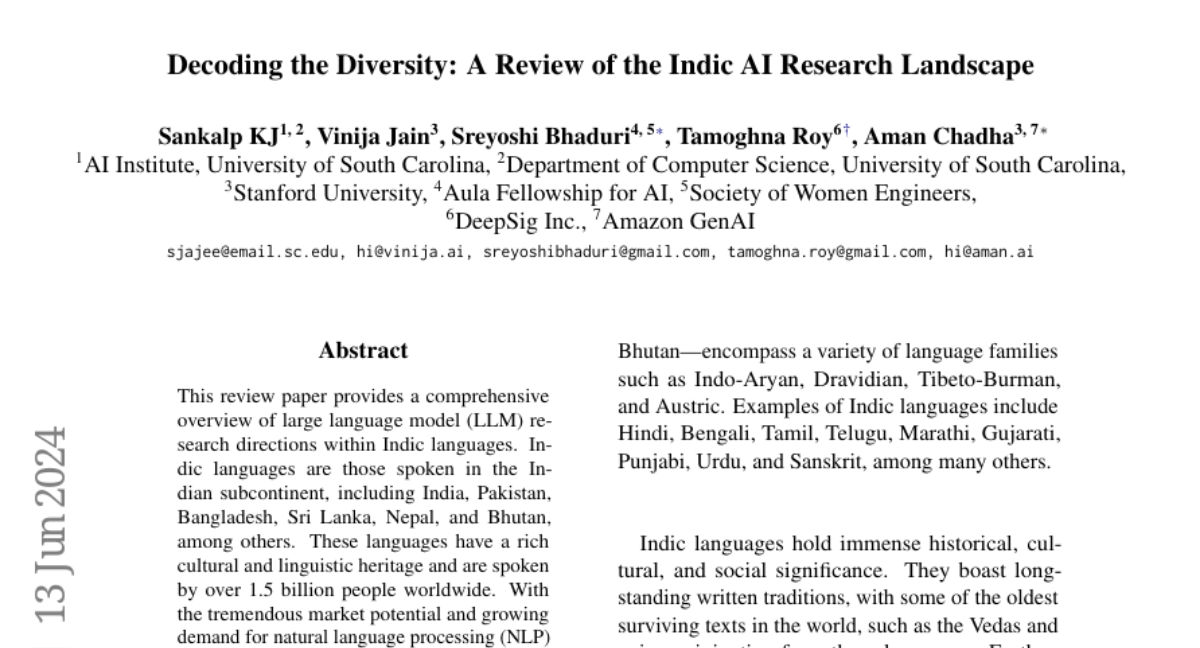Decoding the Diversity: A Review of the Indic AI Research Landscape
Sankalp KJ, Vinija Jain, Sreyoshi Bhaduri, Tamoghna Roy, Aman Chadha
2024-06-17

Summary
This paper provides a detailed overview of research related to large language models (LLMs) specifically for Indic languages, which are spoken in countries like India, Pakistan, and Bangladesh. It highlights recent advancements and challenges in developing AI applications for these languages.
What's the problem?
Indic languages, which are spoken by over 1.5 billion people, have unique characteristics and complexities that make them difficult to work with in natural language processing (NLP). Many existing AI models are trained primarily on English or other widely-used languages, leading to issues like limited data availability and a lack of standardized approaches for Indic languages. This makes it challenging to create effective AI tools that can understand and generate text in these languages.
What's the solution?
The authors of the paper reviewed 84 recent publications to identify various research directions in the field. They categorized these into areas such as developing new LLMs, fine-tuning existing models, creating language-specific datasets (corpora), and establishing benchmarks for evaluation. By organizing this information, the paper aims to provide a roadmap for researchers working on NLP applications for Indic languages, helping them navigate the unique challenges presented by these languages.
Why it matters?
This research is significant because it addresses the growing demand for AI applications in diverse languages, particularly in regions with rich cultural heritages like the Indian subcontinent. By focusing on Indic languages, the paper contributes to the development of more accurate and efficient AI tools, which can enhance communication and access to information for millions of speakers.
Abstract
This review paper provides a comprehensive overview of large language model (LLM) research directions within Indic languages. Indic languages are those spoken in the Indian subcontinent, including India, Pakistan, Bangladesh, Sri Lanka, Nepal, and Bhutan, among others. These languages have a rich cultural and linguistic heritage and are spoken by over 1.5 billion people worldwide. With the tremendous market potential and growing demand for natural language processing (NLP) based applications in diverse languages, generative applications for Indic languages pose unique challenges and opportunities for research. Our paper deep dives into the recent advancements in Indic generative modeling, contributing with a taxonomy of research directions, tabulating 84 recent publications. Research directions surveyed in this paper include LLM development, fine-tuning existing LLMs, development of corpora, benchmarking and evaluation, as well as publications around specific techniques, tools, and applications. We found that researchers across the publications emphasize the challenges associated with limited data availability, lack of standardization, and the peculiar linguistic complexities of Indic languages. This work aims to serve as a valuable resource for researchers and practitioners working in the field of NLP, particularly those focused on Indic languages, and contributes to the development of more accurate and efficient LLM applications for these languages.